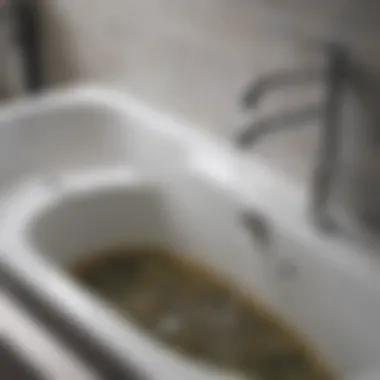Understanding Flush Toilet Water Backup in Bathtubs


Intro
Flush toilet water rising in bathtubs presents a puzzling issue that many homeowners encounter. This phenomenon not only poses a significant inconvenience but also flags potential plumbing concerns that could worsen if not addressed. Understanding why this happens can save you from costly repairs and ensure the integrity of your home’s plumbing system.
The Core Issue
At its heart, this problem is rooted in the plumbing network of a house. When water intended for the toilet finds its way back through the plumbing and into the bathtub, it often signals a blockage in the drainage system. This can result from a variety of factors including:
- Clogs: Accumulation of debris, hair, or even tree roots can obstruct pipes.
- Backpressure: Issues with the sewer line can create pressure, pushing water back through the drains.
- Ventilation problems: Adequate airflow is critical in plumbing systems; otherwise, it can lead to improper drainage.
Such reasons combined underscore the need for prompt attention whenever you notice toilet water rising in unexpected places.
Plumbing Systems Explained
Understanding plumbing is vital to tackling these issues. The average plumbing system consists of a network of pipes designed to transport waste effectively away from your home. It operates on a gravitational basis, where the waste flows downwards into the main sewer line.
However, if there is a break or obstruction, the system fails. Adverse conditions can lead to serious backups, affecting various outlets in the home, especially the bathtub. A professional plumber can assess the plumbing layout and detect any underlying issues that might not be visible to the untrained eye.
Homeowner Maintenance
Homeowners play a crucial role in preventing such problems. Regular maintenance, including:
- Routine inspections: Look for signs of leaks or unusual water flow in drains.
- Clearing clogs: Use tools like plungers or drain snakes to clear minor blockages before they escalate.
- Professional checks: Engage a plumbing expert at least once a year to ensure the system remains intact.
Practicing preventive care can mitigate the frustrations associated with plumbing issues and also increase the longevity of your systems.
"Proactive maintenance is key. A small issue today can balloon into a much larger problem."
Finale
In summary, the phenomenon of flush toilet water rising in bathtubs signals deeper issues within the plumbing system. Recognizing the core problems, understanding the plumbing infrastructure, and committing to regular maintenance are crucial steps for any homeowner. By taking action early, you can prevent more severe plumbing nightmares in the future.
Foreword
This phenomenon often serves as a clear warning sign of underlying plumbing problems that require attention. Homeowners should not underestimate the implications of flush toilet water rising in bathtubs. It signals possible blockages, malfunctions, or other serious issues within a home’s plumbing framework. Understanding the mechanics at play enables individuals to address these problems before they escalate into more complicated and costly repairs.
By recognizing the significance of this issue, homeowners can adopt preventive measures and maintenance strategies. This knowledge equips them to manage their plumbing systems effectively and maintain a comfortable bathroom environment. The following sections will delve into the critical aspects surrounding this problem, focusing on the anatomy of household plumbing, identifying symptoms, understanding root causes, health risks, and the value of professional assistance.
Understanding Household Plumbing Systems
Understanding household plumbing systems is essential for grasping why flush toilet water can rise in bathtubs. The plumbing network in a home is more than just pipes. It encompasses various components working together to manage water distribution and waste removal effectively. This section lays the groundwork for understanding the forthcoming issues related to plumbing failures and how they manifest, particularly in the context of backflow scenarios.
Basic Components of a Plumbing System
Every plumbing system comprises basic components. These include pipes, fittings, faucets, valves, and fixtures. Each has its specified function, and any failure can lead to significant issues.


- Pipes: The pathways through which water travels. We have supply lines bringing in clean water and drain pipes carrying away waste.
- Fittings: Connect various lengths of pipes and allow changes in direction.
- Fixtures: Include sinks, toilets, and bathtubs, interacting with the plumbing system.
- Valves: Control water flow, including shut-off and pressure relief valves.
When any of these components malfunction, it can critically affect the entire system, causing backups and leaks.
Role of Waste Pipes and Drains
Waste pipes and drains have crucial roles in any plumbing system. Their primary function is to transport wastewater away from appliances and fixtures and direct it toward the municipal sewer or a septic system.
- Sanitary Drains: Designed to carry away human waste and greywater. They have specific diameters and slopes to ensure proper flow.
- Vents: Essential for maintaining airflow within the drainage system, preventing pressure buildup that can cause backflow.
If waste pipes are clogged or improperly aligned, it can create back pressure, resulting in flush toilet water rising in bathtubs.
Functionality of the Vent System
The vent system is an often-overlooked part of plumbing that provides essential functions. Vents connect to drain lines and allow air circulation, which is vital for maintaining balanced pressure within the plumbing system.
- Preventing Siphoning: Vents prevent the siphoning of water from traps, ensuring drains operate correctly.
- Odor Control: They also help eliminate sewer gases from entering living spaces.
Understanding the vent system’s role helps homeowners recognize potential problems. A failure here can directly lead to backups.
The plumbing system in your home operates as a cohesive unit. Understanding these components, their roles, and their interdependencies offers insight into the issues of rising flush toilet water in bathtubs. By maintaining and regularly inspecting these systems, homeowners can potentially avoid costly and inconvenient plumbing failures.
Identifying the Problem: Water Backup in Bathtub
Understanding the issue of water backup in bathtubs is crucial for every homeowner. This problem not only affects the functionality of the bathroom but may also present significant health risks and structural damages if left unresolved. Recognizing the signs early can save time, money, and reduce stress. It is essential to be aware of the common indicators that suggest trouble in your plumbing system, allowing for prompt action and repair.
Common Signs of Backflow
Identifying the common signs of backflow is the first step in tackling this issue effectively. Homeowners should keep an eye out for the following:
- Water standing in bathtubs: This is often the most overt sign that water is not draining properly.
- Gurgling noises from drains: Auditory cues can indicate trapped air, which is often symptomatic of a blockage.
- Unpleasant odors: Foul smells emanating from the bathtub or drains may suggest that wastewater is not being adequately processed.
- Slow drainage: If the water takes longer than normal to drain from the bathtub, it could be an early warning sign of a bigger plumbing issue.
These signs should prompt homeowners to investigate further. If they ignore these indicators, more severe plumbing issues may develop, leading to costly repairs.
Immediate Effects on Bathroom Environment
Once backflow occurs in the bathtub, the immediate impact on the bathroom environment becomes evident. The results can be disturbing and, in some cases, hazardous.
- Increased moisture: This can create an inviting environment for mold and mildew, affecting air quality and overall hygiene.
- Potential contamination: Water from the toilet can introduce harmful bacteria, compounding health risks for family members.
- Unpleasant aesthetics: A bathtub filled with dirty water is unappealing and can deter usage of one of the most utilized areas in any home.
- Damage to fixtures and surfaces: Prolonged exposure to water can lead to property damage, affecting walls, wallpaper, and cabinetry.
Addressing water backup promptly is not just about comfort; it impacts health and home integrity.
By being vigilant and recognizing these signs and effects of water backup, homeowners can harness the importance of timely action to mitigate these risks effectively. Ensuring a functional plumbing system plays a pivotal role in maintaining a healthy living environment.
Root Causes of Water Backflow
Understanding the root causes of water backflow in bathtubs is essential for homeowners. This knowledge allows for effective troubleshooting and maintenance of plumbing systems. Addressing backflow issues promptly can mitigate potential health risks and costly repairs. Key elements include identifying clogs, recognizing toilet drain issues, understanding drain trap functions, and evaluating the impact of tree roots.


Clogs in the Plumbing System
Clogs are frequent culprits in plumbing systems. They can occur anywhere, from the toilet to the pipes leading to the bathtub. Typical causes include hair, soap scum, and foreign objects. Over time, these materials accumulate, narrowing the pipe's diameter. As a result, water movement slows down, leading to backflow situations.
Regular inspections can help to identify early signs of clogs, preventing extensive damage and inconvenience. Preventive measures such as pouring hot water down drains, using baking soda and vinegar, or employing a drain snake can assist in keeping pipes clear.
Issues with the Toilet Drain
Problems with the toilet drain can significantly impact water flow. One common issue is a faulty wax seal. This seal is critical for maintaining the connection between the toilet and the waste line. If compromised, it can lead to leaks and backflow. Additionally, improper installation of toilet components, including flush valves and fill valves, can create dysfunctions that exacerbate the situation.
Homeowners should prioritize checking their toilet for loose parts or signs of wear. Small issues can escalate quickly, leading to more significant concerns if not addressed.
Malfunctioning Drain Traps
Drain traps serve a vital function in preventing sewer gases from entering living spaces. However, if they malfunction, they can also be a source of water backflow. A common issue is a dry trap, where sewer gases can escape. This occurs when there is no water in the trap to create a barrier.
Another concern is the obstruction caused by debris accumulation in the trap. Regular maintenance and flushing of traps can prevent these problems, ensuring they perform their function effectively.
Impact of Tree Roots on Plumbing
Tree roots can pose a serious threat to plumbing systems. As roots search for moisture, they can infiltrate pipes and cause blockages. This intrusion not only disrupts water flow but can also lead to cracks in the pipes, allowing wastewater to leak into surrounding soil.
Homeowners must be vigilant about the placement of trees in their yards. Annual inspections can help identify root issues before they escalate. In cases of severe root intrusion, professional assistance may be necessary to resolve the problem comprehensively.
Understanding these root causes is crucial. By proactively addressing these factors, homeowners can enhance their plumbing system's performance and prevent potential backflow issues.
Potential Health Risks Associated with Backup
The issue of flush toilet water rising in bathtubs is not merely an inconvenience; it poses significant health risks. Understanding these risks is crucial for homeowners, as it impacts not only the quality of their living environment but also their overall well-being. When water backflows into bathtubs, it often carries contaminants that can lead to various health concerns.
Bacterial Contamination Concerns
When wastewater backs up, it introduces bacteria and pathogens from the sewage or toilet waste into the home environment. This can lead to serious health hazards such as gastrointestinal illnesses, infections, and other diseases. Common bacteria found in wastewater include E. coli and Salmonella, which thrive in unsanitary conditions. Individuals with compromised immune systems, children, and the elderly are particularly at risk.
Preventive measures include:
- Keeping a tight seal on the toilet lid during flushing.
- Regularly cleaning toilet and bathtub areas to minimize bacterial growth.
- Using disinfectants to enhance sanitation.
It is essential to address issues quickly upon noticing warning signs. Neglecting the problem can lead to a more severe contamination. To minimize these risks, homeowners should have a basic understanding of their plumbing systems and take timely action.
Long-term Effects on Indoor Air Quality
The presence of backed-up toilet water can also adversely affect indoor air quality. When wastewater fills in bathtubs, it can lead to unusually high levels of humidity and promote mold growth in surrounding areas. Mold spores can circulate in the air, triggering respiratory problems and allergies among inhabitants.
Additionally, foul odors from sewage can permeate through the home, making the environment unpleasant and unhealthy. These odors often indicate the presence of volatile organic compounds (VOCs) that can linger and affect air quality over time.
To maintain better air quality, it is advisable to:


- Ensure adequate ventilation in bathrooms and adjacent rooms.
- Use air purifiers to filter contaminants from the air.
- Regularly check for leaks that can contribute to humidity issues.
In summary, understanding the potential health risks associated with flush toilet water rising in bathtubs is paramount. Bacterial contamination and deteriorating air quality not only threaten physical health but can also diminish the comfort of living spaces.
Preventive Measures and Maintenance Tips
In the context of preventing flush toilet water from rising in bathtubs, it is crucial to recognize the role that proactive maintenance plays. Maintaining the plumbing system helps ensure that waste moves efficiently and reduces the likelihood of backups, saving homeowners from potential stress, costly repairs, and health risks associated with water overflows. These preventive measures encompass a range of practices that not only enhance the longevity of plumbing systems but also optimize their operational efficiency.
Regular Inspections of Plumbing Systems
Regular inspections of plumbing systems are vital to identify early signs of trouble. These inspections can help detect clogs or leaks before they escalate into a significant problem. Homeowners should check water flow rates to ascertain if there are any irregularities. Additionally, observing how quickly the bathtub drains after use is another indicator of drainage health.
It is advisable to schedule professional plumbing inspections at least once a year. During these visits, plumbers can assess key components such as pipes, fixtures, and drain traps to ensure everything is functioning smoothly. A proactive approach can save time and money in the long run by addressing minor issues before they become major headaches.
Use of Drain Screens and Filters
Installing drain screens or filters is a cost-effective way to prevent debris from entering the plumbing system. Hair, soap residue, and other materials can quickly gather in pipes, leading to clogs that might cause backups. Screens serve as a barrier, maintaining the flow within pipes and encouraging waste to be carried away effectively.
Regularly cleaning these screens is equally important. Homeowners should inspect and clear the screens monthly, ensuring that they do not become obstructed. This small step can make a significant difference in preventing more severe plumbing issues down the line.
Proper Disposal of Waste Products
The disposal of waste products plays an essential role in maintaining a healthy plumbing system. Many common items should never be flushed down the toilet, including:
- Feminine hygiene products
- Baby wipes and other disposable wipes
- Grease or oil
- Food remnants
Proper disposal involves utilizing appropriate waste bins. Educating all household members about what can and cannot go down the toilet helps maintain system integrity. This simple habit fosters an informed household and reduces the risks associated with clogs and backups.
Assessing the Need for Professional Help
Understanding when to seek professional assistance in plumbing matters is crucial for any homeowner. The rising of flush toilet water in bathtubs is not an everyday occurrence and can signify deeper plumbing issues that require expert intervention. Addressing such problems promptly can prevent extensive water damage and health hazards within the home.
One primary reason to consider contacting a plumber is the complexity of plumbing systems. Many homeowners may feel comfortable handling minor issues, like clogs, but the intricate nature of plumbing installations often makes it difficult to diagnose problems without proper training. A professional can analyze the situation thoroughly, using their expertise to identify underlying issues that may not be apparent.
Additionally, hiring a plumber can provide several benefits:
- Expert evaluation: Licensed plumbers have the experience to pinpoint the exact cause of backflow problems.
- Safety Assurance: Handling sewage and plumbing can involve health risks, and trained professionals are equipped to manage these safely.
- Long-term Solution: Professionals often provide solutions that not only fix the immediate problem but also help prevent future occurrences.
Finale
The conclusion of this article serves not only as a closing statement but as an essential recap of vital insights concerning the issue of flush toilet water rising in bathtubs. Understanding this phenomenon is crucial because it highlights the interconnectedness of household plumbing systems and the significant repercussions that arise from neglecting them.
In summary, this topic underscores several key elements that are paramount to maintaining a functional bathroom environment. By recognizing the symptoms of water backup and acknowledging its potential roots, homeowners can exercise preventive measures that significantly mitigate long-term hazards. Regular inspections and maintenance can ward off many mishaps that lead to backflow situations. Likewise, an informed approach to waste management is indispensable.
Furthermore, understanding when to seek professional help is a vital aspect that should not be overlooked. This ensures that the issues are addressed comprehensively, leaving no room for recurrence. Homeowners who possess knowledge about their plumbing systems will harness not only a sense of empowerment but also peace of mind.
The implications of this phenomenon extend beyond mere inconvenience. A flooded bathtub can provoke health concerns, damage property, and impede daily routines. Therefore, grasping the intricacies of plumbing, maintenance strategies, and signs of trouble can be incredibly beneficial.
By synthesizing the information presented throughout the article, readers can cultivate a proactive stance towards plumbing issues, ensuring their bathrooms remain efficient and safe. Ultimately, fostering awareness of these matters contributes to an overall healthier home environment, preserving both property value and personal safety.
"Knowledge is power, especially when it comes to managing the complexities of household plumbing."
Like any homeowner, staying informed is the key to prevention. With the right understanding, flush toilet water rising in bathtubs can become a relic of the past.







